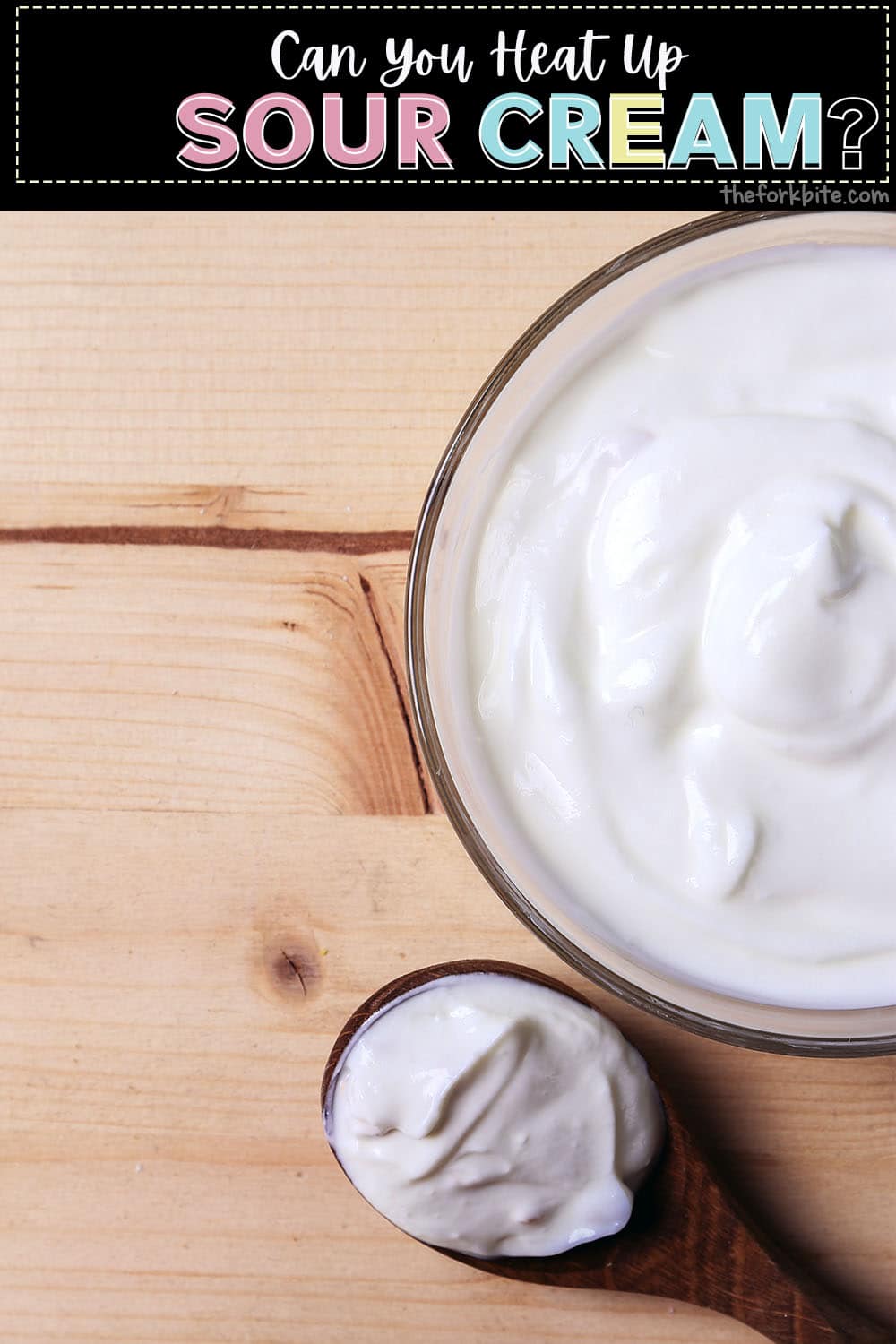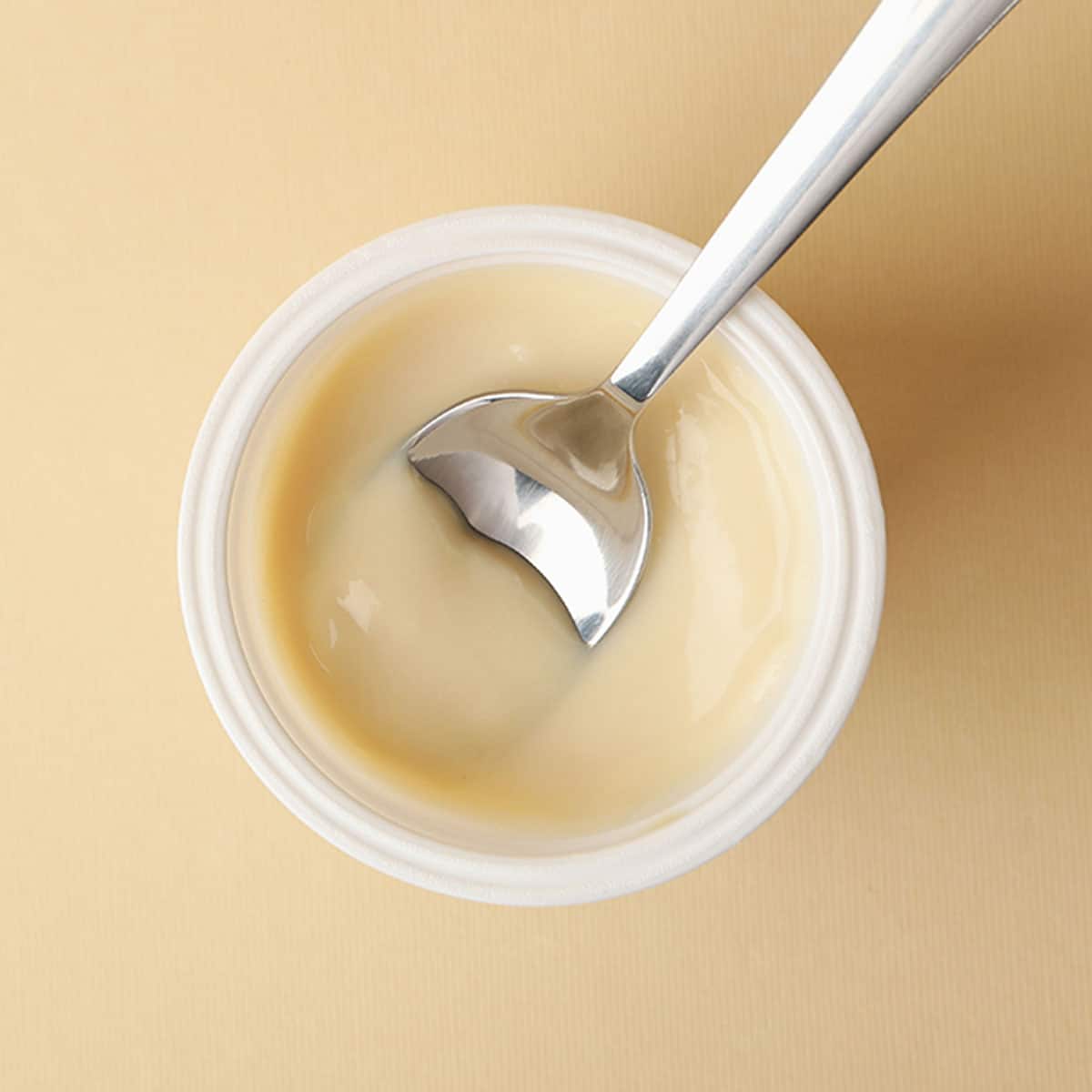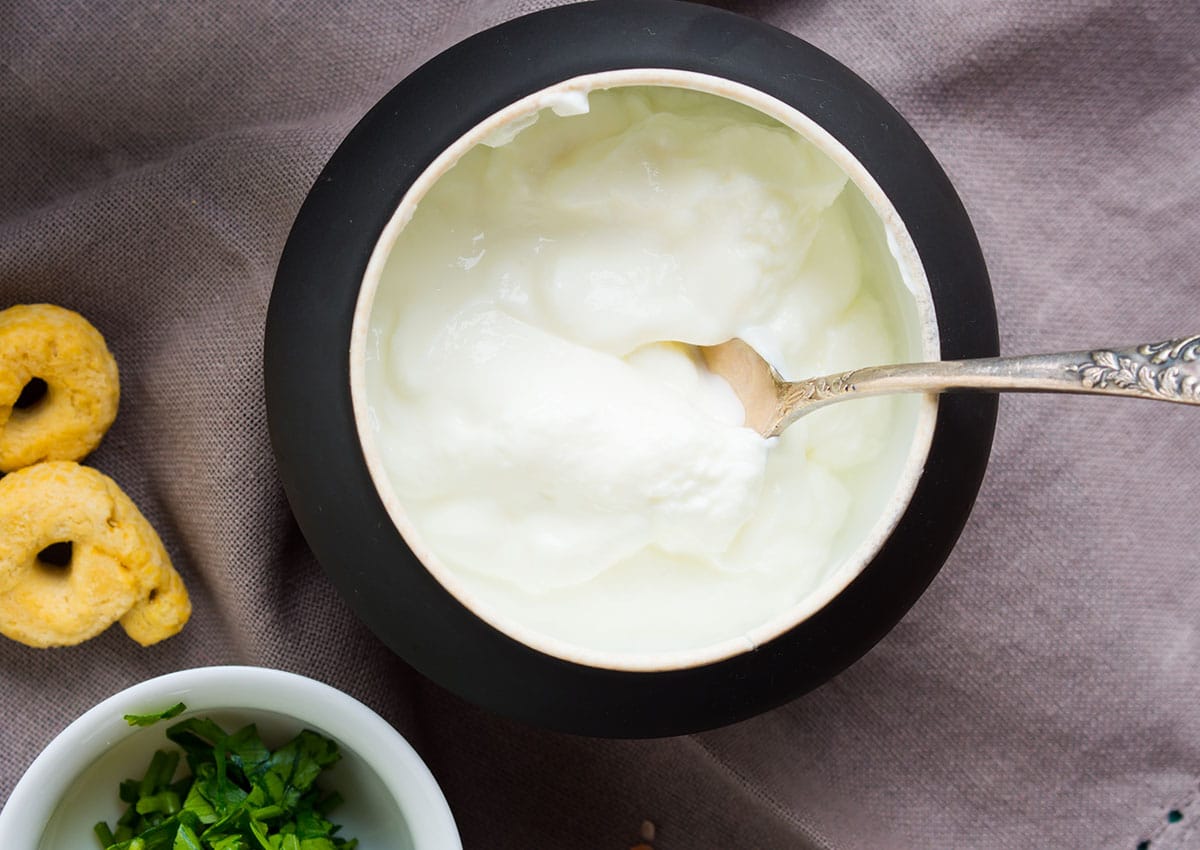Can sour cream be heated? Yes, you can heat sour cream, but it will change significantly in texture after heating, so you should treat it accordingly.
Originally from Eastern and Central European cuisines, sour cream is now a staple in most kitchens in the US.
Jump to:
This gorgeous creamy dairy product is used for thickening sauces, making dips, to create silky frostings, and it is wonderful when heaped onto baked potatoes or dolloped into soups.
Have you ever tried to heat it? Did it go wrong? Did you end up with a sad, split thing that had lost all of its billowy lightness?
It's what happens to many people who live on believing they can't heat sour cream.
Well, they're wrong, and if you are one of the misguided, read on, and I will tell you how you can successfully heat sour cream, be it full fat or light.

Can sour cream be heated?
Sour cream starts as dairy cream, adding lactic acid-producing bacteria.
It would have been covered by cheesecloth and left overnight in a warm place for the culture to develop in the old days. The next morning, the top layer will turn into sour cream. You would then skim it off, use it as you please, and store any leftovers in a nice, cold place where it would keep for up to two days.
It can be done when it comes to heating sour cream, but the magic word is "gently."
It's the same whether you are heating it on its own or with other ingredients - gently does it. The other thing you need to consider is the variety of sour cream you are heating. It is something we will discuss in more detail a little later on.
Heating sour cream in the microwave
Before discussing how to heat sour cream in your microwave, we need to start with the word warning.
Therefore, it is unsafe to do so. It could cause harmful chemicals to leach out of the plastic and into the cream. It's not just sour cream you need to be careful of when it comes to microwaving foods in their original containers.
Plastic containers can be engineered for microwave-safe cooking as they are in ready meals that can be microwaved. But if they are not designed for the purpose, don't risk it. Before microwaving any foods in plastic containers, it is recommended to read the label carefully.

Step-by-step instructions
- Transfer the sour cream from its original container into a microwave-safe dish.
- Position a piece of kitchen paper towel over the top of the dish to act as a loose lid and prevent any splattering.
- Change the power setting on your microwave to medium, and microwave the cream for 15 seconds per tablespoon of sour cream. You should interrupt the heating process to stir every five seconds, ensuring the heat is evenly distributed.
- It is recommended to only heat one or two tablespoons at a time. Larger quantities can easily overheat and, in doing so, could curdle and separate.
- If you want to microwave a larger amount of sour cream, do it one or two tablespoons at a time, transferring the warmed cream into a warm bowl.
You'll get the best results if you have time to allow the sour cream to naturally get up to room temperature before you start heating it.
Things to consider before reheating sour cream
The consensus is that you should not reheat sour cream. However, if it has been mixed with other foods like burritos and tacos, you can reheat them. Bearing in mind that sour cream is not a heat-stable product, the likelihood is that you will end up with a rather soggy result.
You'll get the best results by removing as much of the sour cream as possible before reheating and adding fresh sour cream when you serve. Different foods will have different reactions in terms of reheating. What about casseroles and stews?
Obviously, these are already soggy anyway, but the only thing to bear is that if you overheat any leftovers, the sour cream could separate when reheating.
One way of avoiding this is to add sour cream at the end of the cooking process.
The importance of fat content when microwaving sour cream
Is the sour cream you bought full-fat, light, zero-fat, or non-dairy? The reason for asking the question is that they all react slightly differently to being heated.
Full and reduced-fat versions will heat better than non-fat varieties.
You can do it, but it is more tricky. Fat-free or low-fat creams don't tolerate heat as well as fuller fat versions - and even they have to be gentled.

Can you freeze sour cream?
- Yes, you can freeze sour cream, but you need to be aware that its texture will change hugely; however, if you use it in casseroles, soups, and stews, its looks and texture will be disguised - no problem.
You can also freeze other cooked dishes containing sour creams, such as beef stroganoff and enchiladas.
The one thing that never works is using defrosted frozen sour cream on its own as a dressing. It's a no-no; you will shoot the texture to hell. It goes all grainy. It also makes it taste tangier, too - tangier than it should. However, you would probably get away with mixing it with other ingredients in a recipe.
One last thing. It's common sense, but you must freeze sour cream while it is still fresh. Unsurprisingly, if you freeze it after it's gone bad, it will still be bad when it's defrosted.
How to freeze dishes that include sour cream
As I mentioned above, freezing and defrosting dishes that have sour cream as an ingredient will make them soggy.
You can minimize the sogginess by following these steps.
- Cool the dish in your fridge.
- Pack liquid dishes like casseroles in freezer-safe plastic Ziploc bags and store them upright to avoid accidental spillage.
- Alternatively, use an aluminum pan or a baking tray lined and generously overlapped with aluminum foil or freezer paper. Once the food is in position, create a pouch by sealing together the edges.
- Once frozen, remove it from the pan or tray.
- Label and date.
It's also advisable to freeze foods like this in individual portions.
Using frozen sour cream - defrost or not?
How you intend to use frozen sour cream will determine how you should handle it. If you add it to casseroles at the end of cooking, it will defrost in the hot liquid in no time.
If you need to defrost it, you should do so in your fridge. It will take up to a day or two, depending on how much frozen cream there is in the container.
Uses for sour cream
The best way of using sour cream is fresh, straight out of its container. If you notice a slight separation when you open the container - don't worry; it's not a problem.
You can simply pour off any separated liquid or stir it back in - the choice is yours. Sour cream has a lovely subtle sour taste. It's fantastic when added to biscuits and pancakes. You can add it to a cake or muffin recipe to enhance flavor and texture.
Here are some other things for which you can use it:
- A savory sandwich dressing
- In ice cream
- An ingredient in smoothies
- Use it in batters and doughs
- Use it to tone up the flavor of salad dressings
- Use it to make creamy sauces for meat and poultry
- Add tang to rich-tasting desserts.
- Spoon on top of baked potatoes
It is quite versatile. But remember; if you add it to hot, cooked dishes, add it in at the end of cooking to stop it from curdling and separating.
How long does sour cream last?
If you've got a tub of sour cream in your fridge and it's been there for a few days, you might be wondering whether or not it is still safe to eat. It's a fair question.
According to a knowledge piece on the USDA website, sour cream can be stored in a fridge at around 40°F for between 1 to 3 weeks.
Before using, check to ensure there are no signs of mold. We'll talk about these signs a little later.
But, as I mentioned earlier, it's not a problem if you spot a little liquid on the surface. It's just separation, and you can pour the liquid away or mix it back in.
Why does sour cream spoil?
Sour cream is made from pasteurized milk, which is used to kill off any harmful bacteria. It then undergoes a fermentation process using healthy bacteria that produce lactic acid. It is what gives sour cream its delicious sour taste.
If you buy commercially produced sour cream from your local grocery store or supermarket, you can rest assured that it meets strict safety standards.
However, if you make it yourself, you must be aware of the danger of developing harmful bacteria.
Be sure to sterilize all the equipment you use in the process as specified in this "article."
Don't forget that sour cream is essentially a living product. It contains live cultures not killed off by the commercial sterile canning process.
Spoiling agents
The cultures that give sour cream its flavor result from friendly bacterial growth.
Those same circumstances can also be taken advantage of by harmful bacteria which make you ill.
These little nasties can establish themselves in sour cream if kept in the fridge for weeks, and if left outside at room temperature, they can multiply even quicker.
We discussed remixing any separated liquid that could gather on the surface earlier. If the spoon you use is slightly unclean, it can introduce unwanted bacteria.
Spoilage warning signs
The warning signs that indicate sour cream is spoiling or has already spoiled are:
1 Unpleasant odor
Fresh sour cream has virtually no smell. If you check it and it smells moldy or rancid or has a sharp, tangy odor, it is on the way out.
Don't just scoop away any infected areas. Ditch the whole thing. Because of its open texture, any harmful bacteria causing the signs of spoilage will already have spread through the tub.
2 Mold
The same thing applies if you can see spots of mold.
3 Discoloration
If the sour cream appears yellow, that is a sure sign that bacteria and fungi have introduced themselves. Don't take any chances - throw it away.
Like any foodstuff, it will go bad if it isn't handled and stored properly.
You can significantly shorten the shelf life of foods if they aren't handled properly. You never know.
Someone else might have left it outside the fridge at room temperature for a while or could have spooned some out or mixed some surface liquid in with a dirty spoon without your knowledge.
Always do a quick visual and smell test before using.
Best practice when freezing
I mentioned earlier that freezing doesn't kill bacteria. It merely puts them into a state of suspended animation. When awoken by defrosting, they will get to work again, multiplying.
Don't forget that sour cream is a perishable product and must be handled with care.
Here is what to do when freezing dishes containing it.
- With casseroles, freeze at 0°F, which equals approximately minus 17.78°C.
- To thaw - put in your fridge overnight at a temperature of 40°C, approximately 4°C or 5°C.
- To cook directly from the freezer, you need to preheat your oven to a temperature of 400° F
- Pop your casserole in and heat until the temperature in the middle of the casserole reaches 165°F.
Soggy casseroles and stews aren't a problem as they are already liquidy.
But soggy stroganoff or enchiladas are not quite so nice, but that's the danger with freezing, thawing, and reheating some dishes containing sour cream.
Sour cream vs crème fraîche
Some people think that these two products are the same thing. They are not. Yes, they are similar, but there are differences.
1 Fat content
Sour cream contains more protein and has less fat than crème fraîche. That is what makes it more susceptible to curdling when you heat it.
It explains why sour cream is added when the cooking is finished.
The different makeup of crème fraîche makes it a more stable product, and you can add it to hot dishes, and it won't curdle.
2 Acidity
As well as having more protein than crème fraîche, sour cream also contains more acid.
When baking, this extra acidity tends to weaken the gluten structure, which keeps bread and desserts moist. It makes it perfect for baking cakes and muffins.
Crème fraîche, on the other hand, is that much milder, meaning that it blends well with things like scrambled eggs and doesn't add too much acidity.
3 Flavor
When used straight from the carton without warming, sour cream has a tangy, savory hit, making it perfect to use as a condiment for things like burritos, nachos, and tacos.
Speaking of Tex-Mex, it also works brilliantly when dolloped onto chili. It also works well, of course, with Russian dishes like blinis and pelmeni.
Crème fraîche, on the other hand, has a creamier, milder taste, making it better suited for pairing with uncooked dessert recipes, especially when whipped with sugar and vanilla and served alongside the fresh fruit with scones.
You can also add herbs and a hint of citrus to crème fraîche and use it as a dressing on top of sliced meat.
Sour cream vs yogurt
The other product that is often compared with sour cream is yogurt. Both are deliciously creamy and have similarities as well as differences.
Let's start with the similarities.
- They both have a creamy, tangy flavor.
- Both are nutritionally rich.
- They are both dairy products.
- They contain useful quantities of calcium and vitamins.
- Both are produced by fermentation.
- They also both have probiotics or "good" bacteria, which are credited with helping to promote a healthy gut.
Now let's take a look at the differences:
- Sour cream, whether full-fat or fat-free, contains more calories than Greek yogurt and is also higher in fat. Fat, as you know, can potentially raise your body's cholesterol level.
- Greek yogurt has less fat and fewer calories - approximately 133 cal per serving of fat-free, or 300 calories per serving of full fat. Full-fat sour cream has 443 calories.
- With 71% of your daily protein recommendation, Greek yogurt contains more protein than sour cream.
- Sour cream is valued more as a condiment, while Greek yogurt is usually seen more as a dairy snack.
- Sour cream has a relatively high lactose level meaning that people with lactose intolerance should avoid it. Greek yogurt, on the other hand, has a low lactose content.
- Because sour cream contains more whey, which is the water element in milk, it is not as thick as Greek yogurt.
- The flavor of Greek yogurt is stronger than that of sour cream.




